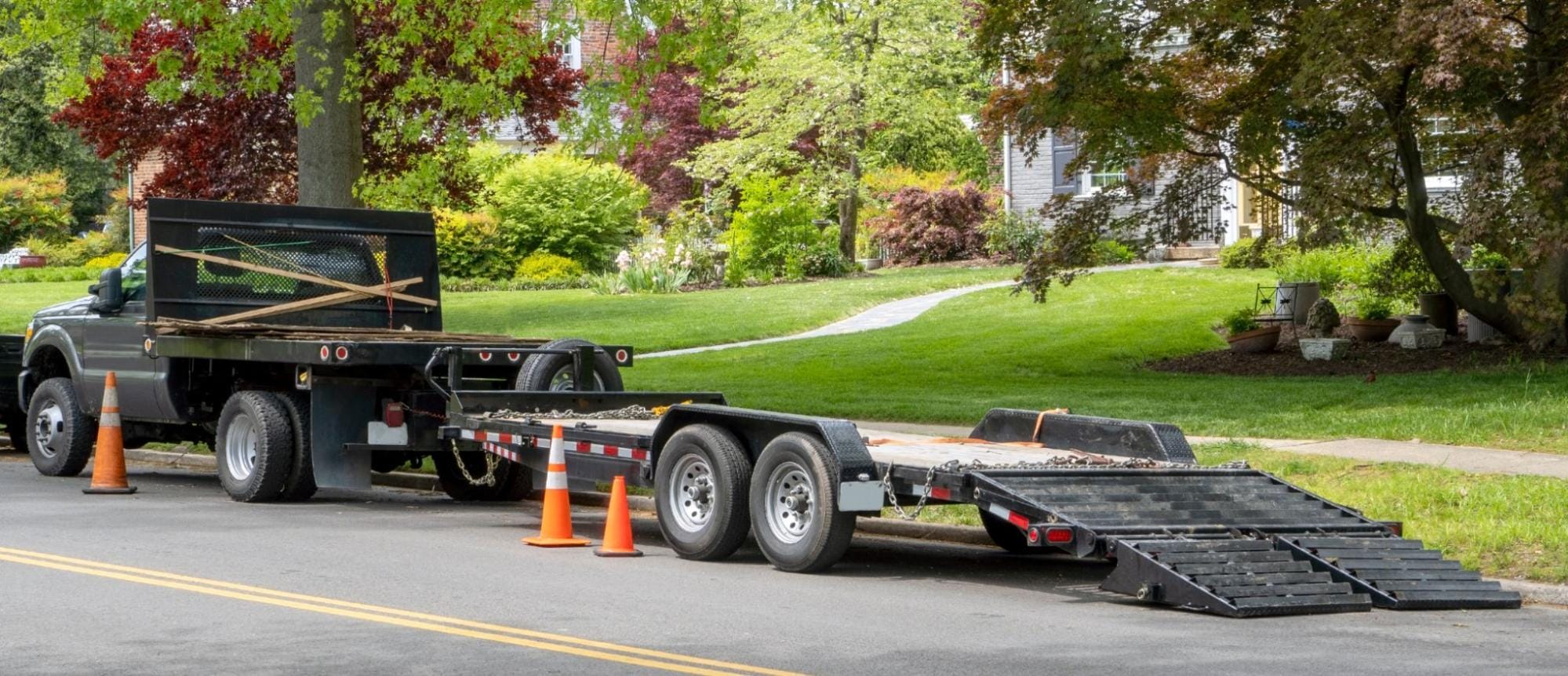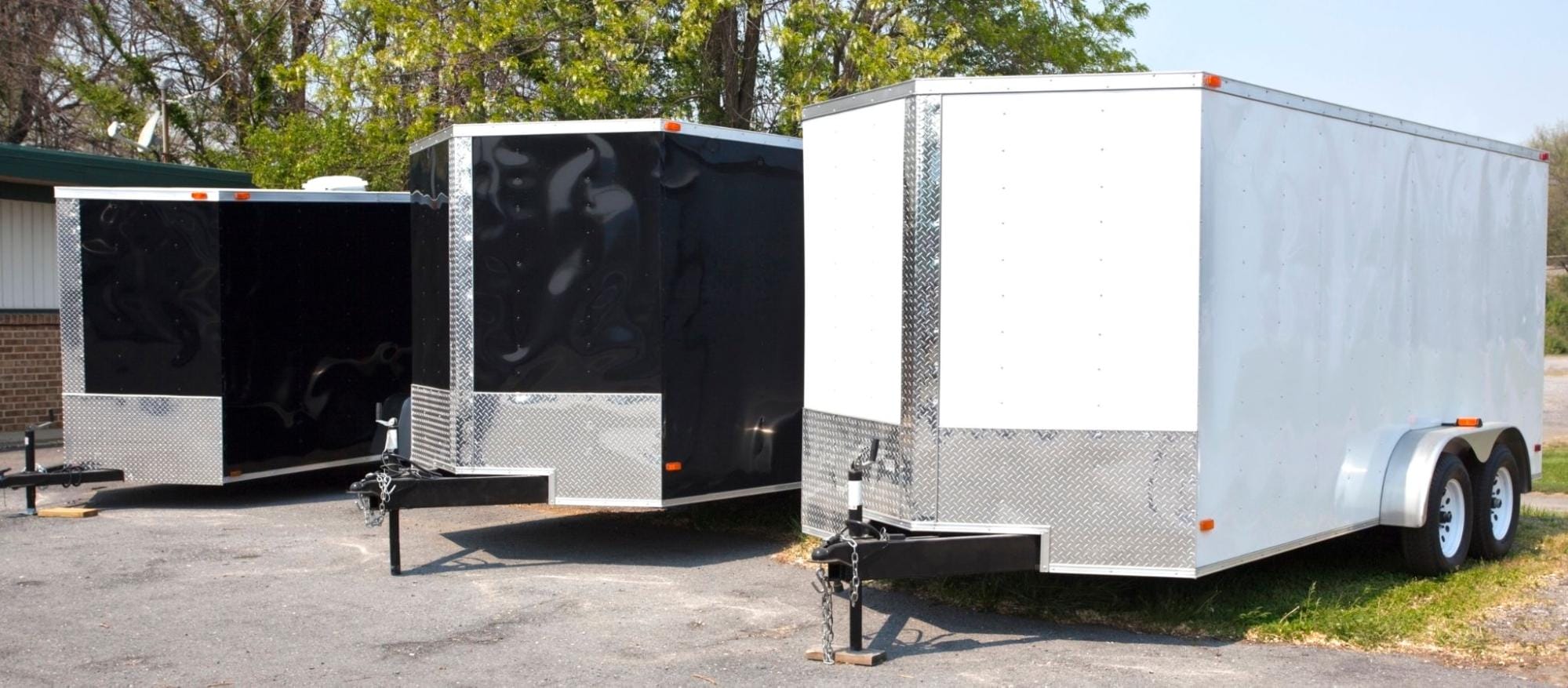

When you start looking for a trailer, one of your first questions will be about the specific trailer sizes available. Many buyers focus on trailer width and length, but picking the right size of trailer involves several additional practical factors.
First and foremost, you will need to think about your cargo weight, what you’re transporting, and where you’ll park it. Armed with this information, you can narrow down your options to a group of trailer sizes.
Most people want to know about standard trailer sizes before they buy. After all, trailer measurements matter more than most people realize. This guide will help you do just that by looking at the full range of trailer sizes, including common trailer sizes and the average trailer length you can expect to find.
We will look at how wide a standard trailer is and cover the basic trailer measurements you need to know. By the time you finish reading, you’ll know exactly what size of trailers will work best for your situation, helping you avoid potentially costly mistakes and a lot of wasted time.
The term ‘standard trailer size’ is actually quite broad, encompassing typical dimensions used for trailers across different industries – and therein lies the problem when defining a standard trailer size: the exact size of a trailer varies depending on its type, with various ‘standard’ trailer sizes widely recognized in the industry.
However, if you want to know how big a trailer should be for your own endeavors, we should at least attempt to address standard trailer sizes. While different jobs need different sizes, most manufacturers stick to common measurements that work well for most uses.
Let’s break down the trailer measurements you will most commonly see:
Looking at trailer width first – most trailers measure between 6 and 8.5 feet across. How wide a standard trailer is matters a lot since you need to know if it’ll fit your cargo and the roads you will travel. Fortunately, these trailer widths work well for most jobs, from hauling regular yard waste to moving large furniture.
In terms of trailer lengths, you have got plenty of options. The length of trailer you’ll find starts at around 8 feet for small utility models. But how long is a trailer when you get into bigger sizes? Some commercial trailers stretch up to 53 feet. For most people doing regular hauling jobs, the average trailer length runs between 14 and 20 feet.
Trailer Tip!
Always verify that the trailer's weight rating matches your towing needs. Exceeding the capacity can strain your vehicle and compromise your safety on the road.
The size of trailers includes height, too – especially if you’re looking at enclosed trailers. While there isn’t a standard trailer height per se, most stand around 7 feet tall, giving you enough room to load taller items without worrying about overhead clearance.
Our trailer size chart shows these common trailer sizes work for most situations. By grasping these basic trailer measurements, you can focus on finding the size of a trailer that matches your haulage needs, taking the guesswork out of picking the right one.

If you need to know how big a trailer should be for your specific needs, you’re certainly not alone – this is the most common (and quite obvious) question we are asked by customers.
Again, the size of trailers varies quite a bit depending on what you’re hauling. Let’s take a look at the most common types and respective trailer sizes so you can find the perfect fit.
In terms of standard trailer sizes, utility trailers are arguably the most versatile. These dependable stalwarts handle everything from small domestic tasks to moving larger equipment. The trailer width usually runs somewhere around 6 to 8.5 feet, while the length of trailer can range anywhere from 8 to 22 feet, generally speaking. They are extremely simple to use and perfect for homeowners who need occasional hauling power without tying up space.
If you need to know how big a trailer needs to be to keep your goods safe from weather and sketchy characters, enclosed trailers offer plenty of more secure options. Their trailer measurements typically start at 8 feet long and can stretch up to 32 feet. The trailer widths range from 5 to 8.5 feet, and most stand about 7 feet tall. These trailers work great for contractors, event companies, or anyone moving valuable items that need protection.
Flatbeds solve the problem of hauling oversized or oddly shaped cargo. Looking at trailer lengths, these models run from 20 to 48 feet, with trailer widths between 8 and 8.5 feet. Since they have no walls, you can load from any angle – perfect for lumber, pipes, or machinery that might not fit in standard trailer sizes.
When an average trailer length doesn’t quite suffice, gooseneck trailers are useful. These heavy-duty haulers measure between 20 and 40 feet long, with a standard trailer width of 8 to 8.5 feet. They connect differently to your truck than other trailer sizes, giving you better control when moving heavy loads.
Car haulers come in both open and enclosed styles, with trailer measurements ranging from 16 to 24 feet in length. The size of a trailer for car transport needs to be just right – typically 8 to 8.5 feet wide to accommodate most vehicles safely.
For those of you asking how wide is a trailer for heavy equipment, these sturdy, dependable haulers usually span 6 to 8.5 feet across. Their trailer lengths run from 14 to 30 feet, giving you plenty of room for tractors, backhoes, or other machinery. The common trailer sizes in this heavy-hauling trailer category focus on general strength and stability, with features like heavy-duty ramps making loading far easier.
Remember, these trailer measurements serve as a loose, general guide. The right size of trailer for you depends on what you’re hauling, how often you’ll use it, and where you plan to store it. Ultimately, you should always check the specific trailer widths and lengths against your haulage needs before making a final choice.
Trailer Tip!
Measure your storage space before purchasing. Trailers often need more room than anticipated, especially for maneuvering into tight spots.
When you see measurements like “7×14” or “8.5×20” in a trailer size chart, they show you the trailer width first, then the length of trailer. Pretty simple and clear, you will probably agree. So if you’re checking how wide a standard trailer is, that first number tells you everything you need to know. For example:
But with those simple numbers, there is a caveat: these trailer measurements usually show the space inside the trailer. Sometimes they might include things like ramps or hitches that stick out, which changes the actual size of a trailer. To that end, always ask about these extras when you are buying a trailer.
Knowing these trailer measurements helps you avoid problems later. You’ll know the trailer will fit where you need to store it and handle whatever you plan to haul. Plus, understanding common trailer sizes makes it much easier to pick the right type.
The following chart outlines the most common trailer sizes, showing their standard dimensions and typical uses. This guide can help you figure out which trailer best suits your goals based on width, length, and intended purpose.
| Trailer Type | Width | Length | Typical Uses |
| Utility Trailer | 5’ to 8’ | 8’ to 22’ | General hauling of landscaping tools, furniture, and small vehicles. |
| Enclosed Trailer | 5’ to 8.5’ | 8’ to 32’ | Protecting cargo like appliances, UTVs, or personal items from the elements. |
| Flatbed Trailer | 6’ to 8.5’ | 12’ to 48’ | Transporting oversized or irregularly shaped items. |
| Gooseneck Trailer | 8’ to 8.5’ | 20’ to 36’ | Heavy-duty tasks such as moving large construction equipment. |
| Car Hauler Trailer | 7’ to 8.5’ | 14’ to 24’ | Towing cars, SUVs, and light trucks. |
| Equipment Trailer | 6.5’ to 8.5’ | 14’ to 20’ | Hauling heavy equipment like tractors or skid steers. |
Ultimately, choosing the right trailer size involves carefully balancing your hauling goals with the size and weight capabilities of your towing vehicle. Here are key factors to consider when selecting a trailer:
Start by looking at what you plan to transport. If you’re hauling small equipment, a utility trailer between 8 and 12 feet long may do the job. For larger tasks – such as moving cars or heavy machinery – trailers measuring up to 36 feet might be better suited. Take your time and assess correctly, as matching the trailer size to your cargo leads to safe and efficient transport.

Your vehicle’s towing capacity sets the maximum weight your trailer and its load can safely reach. Overloading can strain the engine and brakes, making it a fundamental aspect of choosing a trailer size and weight within your vehicle’s limits. For additional help, you may wish to consult the vehicle’s manual for guidance.
While it may sound like an obvious consideration, you will need to think about where you’ll store the trailer when it’s not in use. A compact trailer is more practical if space is limited, while larger trailers may require outdoor storage or specialized facilities.
Review the trailer’s width, height, and length. Wider trailers, up to 8.5 feet, accommodate larger loads but require careful maneuvering. Taller trailers, around 7 feet high, protect taller items during transit.
When in doubt, go slightly larger. Investing in a bigger trailer with more capacity than your immediate needs can save money if your hauling requirements grow later on.
Before you buy a trailer, know your numbers. Width, length, and height all make a huge difference when hauling cargo. A trailer that’s too small won’t carry your load, while one that’s too big wastes space and money. Take time to check the measurements – it’s the best way to find a trailer that actually works for your needs.
Browse Our Vast Selection and Find the Perfect Size for Your Hauling!
https://www.upack.com/how-upack-works/equipment/moving-trailer/size
https://www.goodloading.com/en/blog/truck-transport/dimensions-and-types-of-semi-trailers/
Millennium Trailers is your trusted partner for high-quality trailers at unbeatable prices. Serving all 50 states, we’ve delivered over 5,000 trailers nationwide.
Established in 1998, we’re a company dedicated to meeting your hauling needs with excellence. Whether it’s cargo trailers or custom living quarters, we provide a wide range of options to suit your requirements. Our knowledgeable and friendly team ensures a smooth buying experience with personalized assistance. Proudly offering competitive pricing, state-of-the-art designs, and easy financing options. Committed to customer satisfaction, we strive to simplify the process of finding your perfect trailer.
Choose Millennium Trailers for a reliable, customized solution that delivers quality and value for your investment.
Copyright 1998 – 2023 Millennium Trailers, Inc.